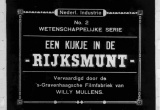Institutionalisation of the School Cinema
As early as the 1910s it was observed that film had an irresistible attraction for children, although the films that were shown in the cinemas were rarely suitable for the delicate sensibilities of a child. This led to local film censorship boards that were responsible for determining if a film was appropriate for young viewers. While some people believed that film was never suitable for children, others were of the opinion that children could benefit from well-founded film programmes. School cinemas originated from this notion.
Cinema forerunner in The Hague
Herman van Capelle started showing educational films in The Hague while he was the director of the Museum ten bate van het Onderwijs (the forerunner of what is now Museon - the Dutch Museum of Education). After receiving a subsidy from the city council of The Hague, the museum was able to start up the first school cinema. From 1918, the Gemeentelijke Haagsche Schoolbioscoop (‘Hague Municipal School Cinema’) became a bit more independent; the institution moved to its own building and schoolmaster David van Staveren was named its director.
Van Staveren worked with filmmaker Willy Mullens on a number of educational films such as Hoe men het geld maakt in Nederland, made in 1918.
Setting up in Rotterdam and elsewhere
The Alderman responsible for education in Rotterdam, Arie de Zeeuw, worked hard to follow The Hague’s example, and the Gemeentelijke Schoolbioscoop was set up in Rotterdam’s shipping museum. A.M. van der Wel, a former schoolmaster, became its director. At the municipal school cinema, Van der Wel served as a film producer, but he was also a filmmaker. There was a substantial shortage of educational films and Van der Wel’s films, which were primarily intended for his own cinema, were snapped up like hotcakes everywhere.
In most communities, separate screenings for educational films were organised; it wasn’t always the city council, however, that took the lead. Many commercial cinemas organised film screenings for primary school students, and each Dutch sociopolitical segment – whether it was Protestant, Catholic, socialist or secular-liberal – had its own solution. Amsterdam, for example, had a Catholic school cinema, but not a municipal school cinema. The production company Polygoon started a travelling school cinema in the second half of the 1920s.
The number of ‘permanent’ school cinemas, however, grew very slowly – in part due to the costs involved. Many schools wanted to decide for themselves what they showed their students, and preferred to have their own teachers screen slides in their own classes.
Budget cuts
Even though some school cinemas were thriving, infrastructure remained a problem. There was very little central organisation in the production and distribution of educational films. Both Rotterdam and The Hague decided to decentralise their school cinemas to cut down on travel time and tram costs. In 1933 the municipal school cinema in Rotterdam closed its doors, primarily as a result of budget cuts; in 1937 the school cinema in The Hague met the same fate.
Screening educational films for children took off nevertheless: with the arrival of cheap and inflammable 16mm cine film, which could be played with a light and simple to operate projector, more and more schools could justify buying their own equipment.
more information
If you are looking for more material from our collection, please contact Film Sales:
sales@eyefilm.nl
phone +31 (0)20 5891 426

